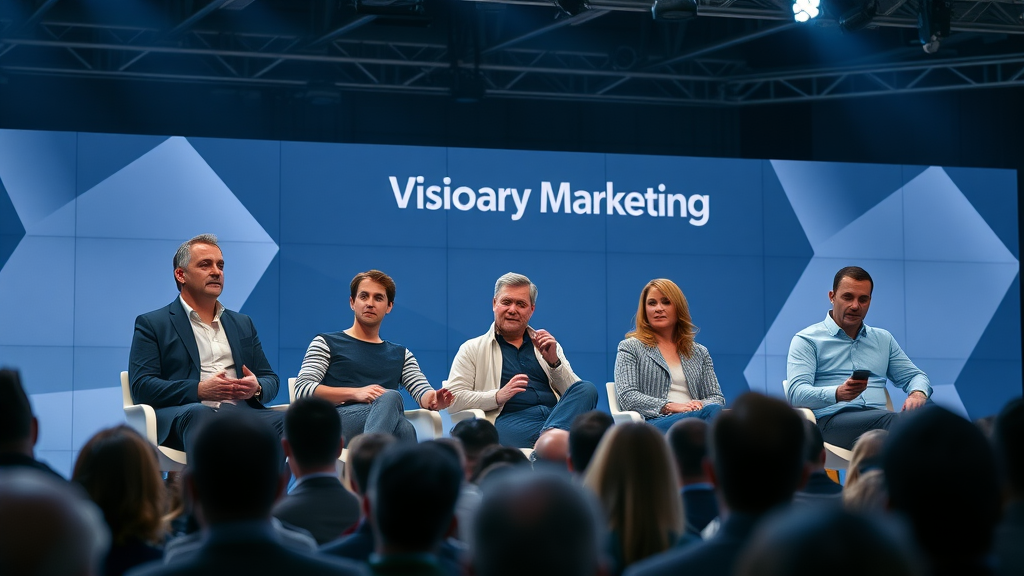Did you know: In 2024, brands are projected to invest over $35 billion in influencer marketing —outpacing growth in TV and print advertising combined? That’s not just a trend; it’s a seismic shift in how companies ignite brand growth, build trust with consumers, and see real, measurable outcomes. If you’re wondering how to ride this explosive wave and put your marketing budget to the best possible use, you’re in the right place. Dive in to uncover the secrets, the strategies, and the fast track to massive brand expansion through influencer marketing.
How Influencer Marketing is Rapidly Transforming Brand Growth
As consumer behaviors pivot and audiences grow weary of traditional advertising, influencer marketing has moved to the center of high-impact brand strategies. Unlike generic digital marketing approaches, brands leveraging influencers tap into an ecosystem where recommendations feel personal, genuine, and immediate. In today’s marketing funnel, influencers drive awareness, boost engagement rates, and fuel conversions in ways traditional advertising simply cannot match. The reason? Influencers have built engaged communities who trust their opinions—a priceless asset in the crowded digital landscape.
Brands across every industry—from fashion and cosmetics to tech and services—are reporting higher measurable outcomes when they integrate influencer campaigns. These collaborations don’t just generate buzz—they drive purchase intent, nurture loyalty, and cut through market noise. As the creator economy rises, so do opportunities: influencer marketing isn’t a side tactic; it’s becoming the marketing hub of the modern brand’s digital strategy. The shift is clear: influencer marketing is no longer a nice-to-have, but a mission-critical lever for rapid brand growth.

Why Influencer Marketing Stands Out Among Modern Marketing Strategies
In the evolving landscape of consumer outreach, influencer marketing has carved a unique niche. Where traditional marketing strategies—like TV or print—rely on broad messaging and passive consumption, influencer marketing thrives on engagement and interactivity. People crave authenticity and relatability; influencer content delivers both by aligning brands with trusted voices who organically integrate products into their daily lives. As a result, brands and influencers together create storytelling that audiences don’t just watch—they participate in.
Today’s digital marketing relies on building genuine creator partnerships capable of moving the needle within hyper-targeted niches. Unlike vanity metrics such as follower counts or likes, modern influencer campaigns zero in on engagement rate, measurable outcomes, and true influence—not just reach. Leveraging the power of social media, influencer marketing outpaces other digital strategies when it comes to trust-building, performance metrics, and driving conversion along the marketing funnel.
Social Media: The Catalyst for Influencer Marketing Success
Social media is the heartbeat of influencer marketing success. Platforms such as Instagram, TikTok, and YouTube provide the ideal stage for creators to interact with their audience in real time. This constant, authentic communication infuses influencer campaigns with energy and immediacy—and lets brands reach audiences where they spend the majority of their time. For example, Instagram Reels and TikTok allow influencers to experiment with agile content formats, blending sponsored posts seamlessly into entertaining, relatable feeds.
What sets social media apart is the two-way dialogue it enables. Consumers are no longer passive recipients of ads—they’re active participants who like, comment, share, and even create content alongside their favorite influencers. These behaviors transform sponsored content from a one-off transaction to an ongoing conversation, fostering loyalty and trust. The impact is clear: brands see faster, more sustainable growth when influencer marketing is aligned with the pulse of social media platforms.

Influencer Campaign Tactics Leading To Fast Brand Growth
Winning influencer campaigns are strategic, data-driven, and deeply collaborative. Brands don’t just select any influencer—they use AI tools and market research to identify creators whose values, aesthetics, and audience align tightly with their own. These partnerships allow brands to create sponsored posts that feel native, not forced, maximizing engagement rates and targeted reach. For instance, influencer campaigns that leverage Instagram Reels or other trending formats are more likely to spark viral growth within a short time frame.
Also crucial are campaign KPIs and performance metrics: brands must look beyond vanity metrics and track real business outcomes—sales, brand mentions, conversion rates, and social commerce impact. Many successful campaigns now use a mix of micro-influencers for niche targeting and macro-influencers for broader reach, achieving a balanced, scalable result. Ultimately, smart brands recognize that influencer marketing works best as a series of ongoing creator partnerships, driving both immediate wins and sustained brand advocacy.
“Influencer marketing isn’t a trend – it’s the future of authentic brand storytelling.”
Influencer Content: Powerful Storytelling for Engagement
At the heart of every successful campaign lies influencer content that prioritizes powerful storytelling. Stories outperform standard ads because they bring products to life, showing consumers how real people use—and love—them. Authentic narratives build a direct bridge between brands and their target audience, tapping into emotions and driving engagement at a much deeper level. In the influencer marketing ecosystem, the story is everything—and it’s how brands cut through the noise.
Performance metrics repeatedly show that influencer content—especially through Instagram Stories, YouTube vlogs, and interactive TikTok challenges—delivers superior engagement rates compared to traditional advertising. By inviting consumers along for the journey, influencers transform sponsored posts into experiences that spark discussion, boost shareability, and sustain attention far longer than static ads ever could. The creative collaboration between brands and influencers results in content formats that resonate and convert.

Leveraging Creator Partnerships for Authenticity
One of the primary reasons influencer marketing excels is its emphasis on authenticity. Brands that openly encourage creative freedom in creator partnerships foster genuine connections with audiences. Instead of rigid scripts, brands collaborate with influencers to produce content that reflects real experiences, opinions, and day-to-day routines. This approach steers clear of the staged, forced-feel of traditional advertisements, making influencer campaigns far more trustworthy.
Creator partnerships also unlock innovative campaign formats. For example, influencers can lead product reviews, share “day-in-the-life” vlogs, or co-host live Q&As, all while integrating brand messaging in seamless ways. These tactics drive higher engagement rates and build enduring loyalty. Brands that recognize the value of creative, authentic influencer content consistently outperform those that micromanage every interaction. The takeaway? Letting creators lead the storytelling process pays off with lasting results.
Maximizing Marketing Budgets Through Influencer Marketing
For brands working with limited or tight marketing budgets , influencer marketing represents a cost-effective way to get significant results. Unlike blanket digital ad spend, influencer campaigns offer a targeted approach that can be scaled according to resources. By focusing on influencers who resonate with niche audiences, brands drive efficient engagement and conversions without overspending. The precision and flexibility offered by influencer marketing make it an essential part of any smart digital strategy.
Additionally, the ROI from influencer marketing often exceeds that of conventional digital or print advertising. Brands can negotiate campaign scopes, choose between one-off sponsored posts or long-term partnerships, and leverage performance metrics for ongoing optimization. This adaptability ensures that every dollar spent works harder in the marketing funnel, yielding measurable outcomes instead of just exposure. For brands watching their bottom line, influencer marketing offers both versatility and accountability—a winning combination in today’s market ecosystem.
Influencer Campaigns Within Tight Marketing Budgets
Launching impactful influencer campaigns doesn’t require massive capital. Many brands succeed by partnering with micro-influencers whose smaller, hyper-engaged followings can outperform larger accounts on a cost-per-engagement basis. By carefully selecting creators who reflect their values and style, brands can maximize ROI without blowing their marketing budgets. For startups and challenger brands, this strategy unlocks social commerce opportunities and delivers efficient, targeted returns, even with smaller investments.
The key is allocating funds strategically: negotiate deliverables, experiment with content formats that prioritize shareability (like Reels or live sessions), and consistently monitor campaign KPIs. Tools now exist to track every dollar and attribute engagement rates to revenue, giving marketers confidence in their ad spend decisions. Ultimately, influencer campaigns can level the playing field, allowing emerging brands to compete effectively alongside industry giants.

| Channel | Average ROI | Targeting Precision | Measurability | Cost Flexibility |
|---|---|---|---|---|
| Influencer Marketing | 11x per $1 spent | High (niche, demographic, location) | Direct (trackable via UTM, codes) | Highly flexible |
| Digital Advertising | 5x per $1 spent | Moderate | Moderate | Variable |
| TV Advertising | 2x per $1 spent | Low (broad audience) | Poor (brand awareness focus) | Inflexible (set airtime costs) |
| Print Advertising | 1.5x per $1 spent | Low | Minimal | Inflexible |
What Makes Influencer Marketing the Smart Choice in 2024 and Beyond
The future of marketing is defined by personalization, accountability, and community engagement—all areas where influencer marketing shines. With brands facing ongoing digital disruption, influencer marketing provides both adaptability and staying power, blending authenticity with performance metrics to drive measurable, scalable outcomes. Rather than chasing fleeting trends, brands are investing in robust creator relationships, leveraging omnichannel campaigns across social media, podcasts, and livestreams for even greater impact.
AI tools are now elevating influencer marketing strategy by streamlining influencer discovery, tracking performance, safeguarding brand safety, and even predicting which content formats will resonate with target demographics. With the growing importance of the creator economy and niche audience targeting, the influencer marketing ecosystem is destined to become even more integral to digital strategy and sustainable growth. Marketers who act now position their brands for a competitive edge in 2024—and well beyond.

AI Tools Revolutionizing Influencer Marketing Strategy
Artificial intelligence is rapidly changing the landscape of influencer marketing through advanced targeting, campaign management, and results measurement. Today’s AI tools parse billions of data points—from engagement rate to demographic insights—helping brands identify the ideal influencers for their goals. Machine learning algorithms can predict which creator partnerships will deliver the best ROI, optimize posting times, and even suggest winning content formats tailored to specific audience segments.
AI tools are also essential for brand safety, automatically vetting influencers for authenticity, avoiding fraud, and flagging inappropriate sponsored posts. As a result, brands are minimizing wasted ad spend and maximizing the impact of their marketing ecosystem. For companies serious about scaling influencer marketing, the integration of digital strategy and next-level AI is quickly becoming the gold standard.
- Identify ideal influencers: Use AI and data-driven platforms to find creators that match your target persona.
- Set clear KPIs: Define goals—impressions, engagement rates, conversions—to stay focused.
- Build authentic relationships: Collaborate on campaign concepts and content formats.
- Monitor campaign results: Use analytics to track measurable outcomes in real time.
- Optimize for continuous improvement: Adjust strategy as insights are gathered.
Case Studies: Real Brands Winning with Influencer Marketing
Leading brands have already demonstrated that influencer marketing isn’t just effective—it’s transformative. Take, for example, a global cosmetics company that shifted 40% of its digital strategy to influencer-led YouTube tutorials and Instagram Reels, seeing a remarkable 20% increase in online sales and a 300% surge in brand mentions within three months. Similarly, an emerging vegan snack brand partnered with micro-influencers in the health and wellness space, leveraging niche engagement to exceed revenue goals while keeping their marketing budget lean.
Even legacy brands in tech and retail are pivoting to influencer campaigns for rapid market penetration. By empowering influencers with creative freedom and transparent KPIs, these brands achieve higher engagement rates, improved customer sentiment, and repeat purchases—outcomes nearly impossible to replicate with traditional advertising. The message is clear: influencer marketing drives real, measurable growth when approached strategically.

Expert Predictions for Influencer Marketing in 2025
As we look to 2025, industry leaders agree that influencer marketing will anchor more of digital ad spend and become increasingly sophisticated, driven by AI, analytics, and the continued shift toward authenticity. Brands will move away from vanity metrics and place greater emphasis on engagement rates, conversion tracking, and lasting creator partnerships. The creator economy will fuel innovation, yielding new content formats and collaborative opportunities that elevate brand storytelling even further.
Expect to see virtual influencers, augmented reality, and seamless integration with social commerce platforms redefine the influencer marketing ecosystem. As marketing budgets shift in response to evolving consumer behavior and platforms like TikTok adapt to new regulations, brands must stay agile and proactive. Authenticity and measurable outcomes will remain the currency of success, rewarding those willing to invest in adaptive, data-driven influencer marketing strategies.
“By 2025, influencer marketing will account for a significant share of digital ad spend as authenticity and audience engagement define success.”
- Scalable results
- Niche audience targeting
- Enhanced brand trust
- Measurable engagement
- Creative collaboration with thought leaders

Common Pitfalls in Influencer Marketing (and How to Avoid Them)
Despite its promise, influencer marketing isn’t foolproof. Common pitfalls include prioritizing follower counts over alignment, misunderstanding performance metrics, and micromanaging influencer content. Brands that focus solely on vanity metrics risk missing real value, as larger audiences don’t always equate to meaningful engagement. Similarly, over-controlling the creative process can stifle authenticity and alienate both creators and their communities.
To avoid these issues, brands should prioritize authentic creator partnerships, invest in analytics to monitor campaign effectiveness, and remain flexible as trends evolve. Transparency in sponsored posts, clear goals, and ongoing feedback loops ensure campaigns are brand-safe but not robotic. With a learning mindset and a willingness to adapt, marketer can sidestep common hazards and maximize the impact of influencer campaigns.
People Also Ask: What will influencer marketing look like in 2025?
By 2025, influencer marketing will integrate seamlessly with social commerce and advanced AI tools. Expect a rise in virtual influencers, interactive content formats, and real-time analytics for tracking measurable outcomes. Brands and influencers will collaborate on deeper, long-term projects, prioritizing authenticity, niche targeting, and audience-driven storytelling. Regulation will bring increased transparency, while technology will help refine campaign strategies for brands of all sizes.

People Also Ask: What is the value of influencer marketing in 2025?
In 2025, the value of influencer marketing will be defined by its role in driving high ROI, scalable reach, and meaningful audience engagement. With advanced analytics and AI-driven targeting, brands can optimize ad spend and connect with consumers on a personal level—something traditional advertising struggles to deliver. As the marketing ecosystem continues to shift toward accountability and authenticity, influencer marketing will represent a significant share of overall marketing budgets and deliver unmatched value.
People Also Ask: What will be the next big trend in influencer marketing?
The next major wave in influencer marketing is the rise of immersive, interactive experiences—think AR-powered campaigns, shoppable live streams, and collaborations between brands and virtual influencers. AI tools will continue to optimize campaign strategy and content personalization, while social platforms may further integrate creator monetization features to fuel the creator economy. Ultimately, expect innovation at the intersection of content, technology, and authenticity.
People Also Ask: Where is marketing going in 2025?
Marketing in 2025 will be fueled by data, community-driven storytelling, and direct engagement. We’ll see brands investing more in content that offers immersive experiences and supports two-way conversations with customers. Influencer marketing, powered by AI and deeply collaborative creator partnerships, will lead this change—creating tighter, more transparent feedback loops and increasingly measurable outcomes across all digital channels.
Best Practices: Building Effective Influencer Campaigns
Building a standout influencer campaign starts with setting well-defined goals and selecting creators who match your audience and values. Once partnerships are established, allow influencers the creative freedom to develop authentic, relatable sponsored content. Establish clear performance metrics but recognize that success is about more than short-term engagement rates—long-term relationships yield ongoing ROI as trust grows between brands and audiences.
Effective campaigns are always refined: use analytics platforms to monitor results, run split tests on content format and messaging, and continually solicit feedback from both creators and their communities. A collaborative, open-minded approach ensures campaigns evolve and remain relevant in a rapidly changing marketing landscape. Above all, prioritize transparency and authenticity to secure both compliance and high-value outcomes.

- Define goals
- Vet influencer authenticity
- Set realistic budgets
- Provide creative freedom
- Measure success metrics
“Success in influencer marketing hinges on collaboration, creativity, and adaptability.”
FAQs about Influencer Marketing
Q: How is influencer marketing different from traditional digital marketing?
A: Influencer marketing leverages personal relationships and trusted voices to reach target audiences, whereas traditional digital marketing relies more on generic messaging and algorithms. This leads to higher engagement and authenticity for brands investing in influencer campaigns.
Q: What are the key metrics to track for influencer campaigns?
A: Focus on engagement rates, conversions, brand mentions, and ROI. Avoid relying solely on vanity metrics like follower counts, which don’t always translate to real impact.
Q: How do brands find the right influencers?
A: Most brands use AI tools and influencer discovery platforms to vet authenticity, analyze engagement, and gauge content fit before establishing partnerships.
Key Takeaways for Brands Pursuing Influencer Marketing
- Influencer marketing is central to modern digital strategy and delivers measurable outcomes.
- Authentic creator partnerships are key to achieving high engagement and lasting brand advocacy.
- AI tools offer new advantages in targeting, monitoring, and optimizing campaign results.
- The influencer marketing ecosystem is rapidly evolving—prioritize adaptability and continual learning.
Conclusion
Don’t wait to harness influencer marketing for your brand’s next leap. Call us at (385) 469-1869 or email at info@solu4u.com today! Let’s unlock massive brand growth—fast.
Sources
- https://influencermarketinghub.com/influencer-marketing-benchmark-report/
- https://creatoriq.com/resources/blog/influencer-marketing-in-2024
- https://www.statista.com/topics/2496/influencer-marketing/
- https://sproutsocial.com/insights/influencer-marketing/
- https://nealschaffer.com/what-is-influencer-marketing/
To deepen your understanding of influencer marketing and its transformative impact on brand growth, consider exploring the following resources:
- “What Is Influencer Marketing? | Mailchimp”
This comprehensive guide delves into the fundamentals of influencer marketing, offering insights into its benefits, strategies for identifying the right influencers, and methods for measuring campaign success. ( mailchimp.com )
- “Influencer Marketing: What is it and how does it work - Heyday Marketing”
This article explores the effectiveness of influencer marketing, highlighting its exponential growth and various applications in e-commerce, such as promoting stores, sharing user-generated content, and offering promotions through influencers. ( heydaymarketing.com )
By engaging with these resources, you’ll gain a more nuanced perspective on how to leverage influencer marketing to achieve substantial brand growth.
 Add Row
Add Row  Add
Add 




Write A Comment